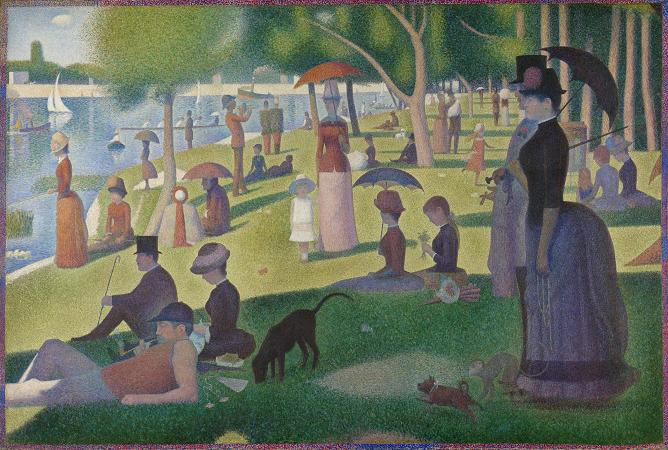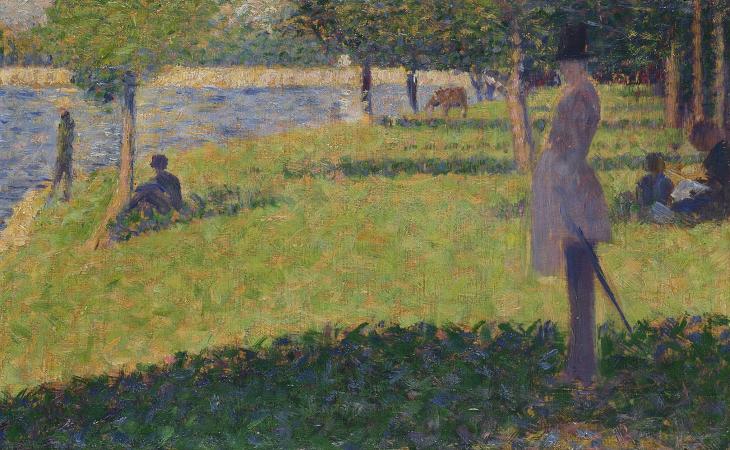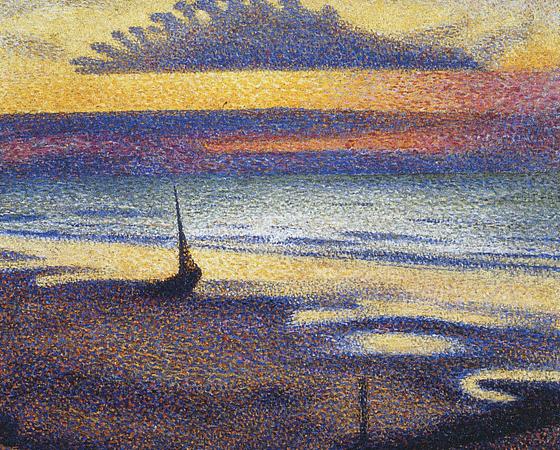Sunday Afternoon on Grande Jatte (1886). Oil on canvas. 208 x 308. A Sunday Afternoon on the Island of La Grande Jatte painted in 1884, is Georges Seurat's most famous work. It is a leading example of pointillist technique, executed on a large canvas. Seurat's composition includes a number of Parisians at a park on the banks of the River Seine. In 1879 Georges Seurat enlisted as a soldier in the French army and was back home by 1880. Later, he ran a small painter's studio in Paris, and in 1883 showed his work publicly for the first time. The following year, Seurat began to work on La Grande Jatte and exhibited the painting in the spring of 1886 with the Impressionists. With La Grande Jatte, Seurat was immediately acknowledged as the leader of a new and rebellious form of Impressionism called Neo-Impressionism. Seurat painted A Sunday Afternoon between May 1884 and March 1885, and from October 1885 to May 1886, focusing meticulously on the landscape of the park. He reworked the original and completed numerous preliminary drawings and oil sketches. He sat in the park, creating numerous sketches of the various figures in order to perfect their form. He concentrated on issues of colour, light, and form. The painting is approximately 2 by 3 meters in size. Inspired by optical effects and perception inherent in the color theories of Michel Eugene Chevreul, Ogden Rood and others, Seurat adapted this scientific research to his painting. Seurat contrasted miniature dots or small brushstrokes of colors that when unified optically in the human eye were perceived as a single shade or hue. He believed that this form of painting, called Divisionism at the time but now known as Pointillism, would make the colors more brilliant and powerful than standard brushstrokes. The use of dots of almost uniform size came in the second year of his work on the painting, 1885-86. To make the experience of the painting even more vivid, he surrounded it with a frame of painted dots, which in turn he enclosed with a pure white, wooden frame, which is how the painting is exhibited today at the Art Institute of Chicago. The Island of la Grande Jatte is located at the very gates of Paris, lying in the Seine between Neuilly and Levallois-Perret, a short distance from where La Defense business district currently stands. Although for many years it was an industrial site, it is today the site of a public garden and a housing development. When Seurat began the painting in 1884, the island was a bucolic retreat far from the urban center. The painting was first exhibited at the eighth Impressionist exhibition in May 1886, then in August 1886, dominating the second Salon of the Societe des Artistes Independants, of which Seurat had been a founder in 1884. Seurat was extremely disciplined, always serious, and private to the point of secretiveness, for the most part, steering his own steady course. As a painter, he wanted to make a difference in the history of art and with La Grand Jatte, succeeded. Seurat's painting was a mirror impression of his own painting, Bathers at Asnieres, completed shortly before, in 1884. Whereas the bathers in that earlier painting are doused in light, almost every figure on La Grande Jatte appears to be cast in shadow, either under trees or an umbrella, or from another person. For Parisians, Sunday was the day to escape the heat of the city and head for the shade of the trees and the cool breezes that came off the river. And at first glance, the viewer sees many different people relaxing in a park by the river. On the right, a fashionable couple, the woman with the sunshade and the man in his top hat, are on a stroll. On the left, another woman who is also well dressed extends her fishing pole over the water. There is a small man with the black hat and thin cane looking at the river, and a white dog with a brown head, a woman knitting, a man playing a horn, two soldiers standing at attention as the musician plays, and a woman hunched under an orange umbrella. Seurat also painted a man with a pipe, a woman under a parasol in a boat filled with rowers, and a couple admiring their infant child. Some of the characters are doing curious things. The lady on the right side has a monkey on a leash. A lady on the left near the river bank is fishing. The area was known at the time as being a place to procure prostitutes among the bourgeoisie, a likely allusion of the otherwise odd fishing rod. In the painting's center stands a little girl dressed in white, who stares directly at the viewer of the painting. This may be interpreted as someone who is silently questioning the audience: What will become of these people and their class? Seurat paints their prospects bleakly, cloaked as they are in shadow and suspicion of sin.
more...








